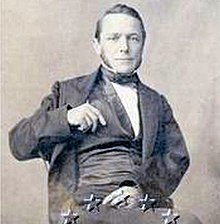John C. Trautwine
John Cresson Trautwine (born March 30, 1810 in Philadelphia , † September 14, 1883 ibid) was an American civil engineer, architect and author. As an expert and consultant for several canal projects in North and South America, he was remembered above all for his prediction that a canal through Panama would not be feasible.
Life
Trautwine began in the office of William Strickland , an architect and one of the first engineers who devoted himself to the new technology of rail transport , to study civil engineering and helped with the construction of the second building (1833-1901) of the United States Mint in Philadelphia. Under Strickland's guidance, Trautwine drew one of the first maps of Maryland in 1835, on the basis of which the Wilmington and Susquehanna Railroad Company (W&S) planned a railway line from Wilmington ( Delaware ) to Maryland , a section of which, the Wilmington / Newark Line , still extends to ours Time is served.
The first building for Gettysburg College , the Pennsylvania Hall , was designed by Trautwine according to his own plans in 1835 in the style of a Greek temple with four columns in the portico .
After a brief stint on the Philadelphia and Trenton Railroad in 1836, he moved in the same year as a railroad engineer to the Hiawassee Railway , which was planning a railway line between Georgia and Tennessee .
In 1838 Trautwine worked again with Strickland as his assistant for the Wilmington and Susquehanna Railroad Company , which had partnered with three other railroad companies to plan and build the first rail link from Philadelphia to Baltimore . This connection is now part of the so-called Northeast Corridor , which is served by Amtrak .
In 1850 he was commissioned to measure the route of the Panama Railway to Panama. In 1856 he took over the planning of a railway connection for the Lackawanna and Lanesborough Railway in Susquehanna County , ( Pennsylvania ) back in the USA and in 1857 the surveying of a railway route through Honduras .
Together with George M. Totten (1808-1884) he built a canal (Canal del Dique) between a bay in Cartagena and the Río Magdalena in Colombia . Trautwine also designed the docks in the port of Montreal .
Fonts
Several of Trautwine's writings developed into standard works in US engineering. The Civil Engineer's Pocket Book , which he wrote, was long considered the bible of engineers in the US and was revised several times by his son John Cresson Trautwine, Jr. (1850-1924) and his grandson JC Trautwine 3rd (1878-1949) and reissued. The publisher John Wiley & Sons sold a total of almost 100,000 copies of Trautwine's Pocket Book by 1911.
George L. Vose (1831–1910), a renowned professor at Bowdoin College , counted three books written by Trautwine among the 16 most important works of American technical literature:
- Method of Calculating the Cubic Contents of Excavations and Embankments (1851)
- Field Practice for Laying out Circular Curves for Railroads (1851)
- Civil Engineer's Pocket-book , 1871 ( 1904 edition prepared by JC Trautwine III)
Web links
- Bio at Philadelphia Buildings
- https://web.archive.org/web/20050221065816/http://www.picturehistory.com/find/p/20642/g/1/mcms.html (photo)
- "Guide to the Trautwine Family Papers, 1834-1947" held at Cornell University
proof
- ↑ Roger W. Moss: maid of Twine, John Cresson (1810-1883). Philadelphia Architects and Buildings, accessed July 22, 2020 .
- ↑ Trautwine, John C. The Maryland State Archives, accessed July 26, 2020 .
- ^ Wilmington / Newark Line. SEPTA Rail, accessed on August 4, 2020 .
- ↑ G. Ronald Couchman: Collection History - Scope and content Notes. (PDF) Gettysburg College, March 8, 2011, pp. 1 to 2 , accessed August 4, 2020 .
- ^ Agnes Addison Gilchrist: A Trautwine Building Identified. (Journal of the Society of Architectural Historians Vol. 17; No. 3 (Autumn, 1958)) JSTOR , pp. 32-33 , accessed August 4, 2020 .
- ^ Horace Hollister: Contributions to the history of the Lackawanna Valley. Internet Archive, 1857, accessed on August 21, 2020 .
- ↑ A visit to the beach of Barú. Colombia Travel, accessed August 21, 2020 .
- ↑ Ricardo Gómez: Canal del Dique: The fight against the weather phenomenon. CDM Smith, accessed August 21, 2020 .
- ↑ Tortonto Library - Reports on the Means of Improving the present harbor and the construction of docks at Montreal
- ^ Karl-Eugen Kurrer : The History of the Theory of Structures. Searching for Equilibrium , Berlin: Ernst & Sohn 2018, p. 178, ISBN 978-3-433-03229-9
- ↑ George L. Vose: Manual for railroad engineers and engineering students: containing the rules and tables needed for the location, construction, and equipment of railroads as built in the United States. Internet Archive, 1883, accessed on August 21, 2020 .
| personal data | |
|---|---|
| SURNAME | Trautwine, John C. |
| ALTERNATIVE NAMES | Trautwine, John Cresson |
| BRIEF DESCRIPTION | American civil and railroad engineer |
| DATE OF BIRTH | March 30, 1810 |
| PLACE OF BIRTH | Philadelphia |
| DATE OF DEATH | September 14, 1883 |
| Place of death | Philadelphia |

